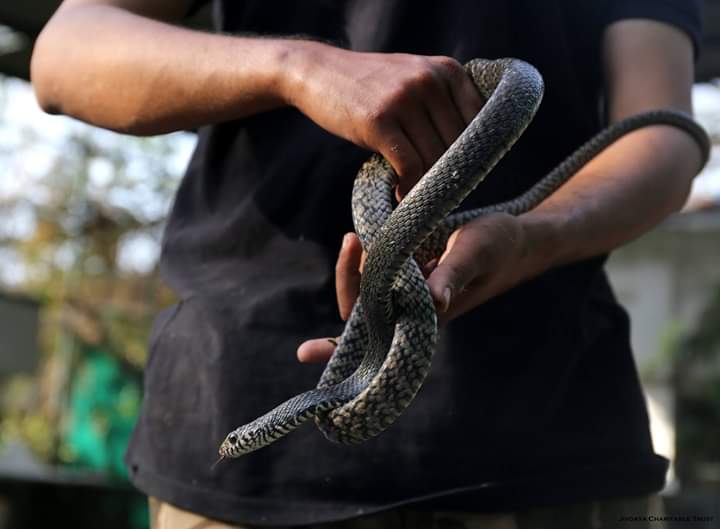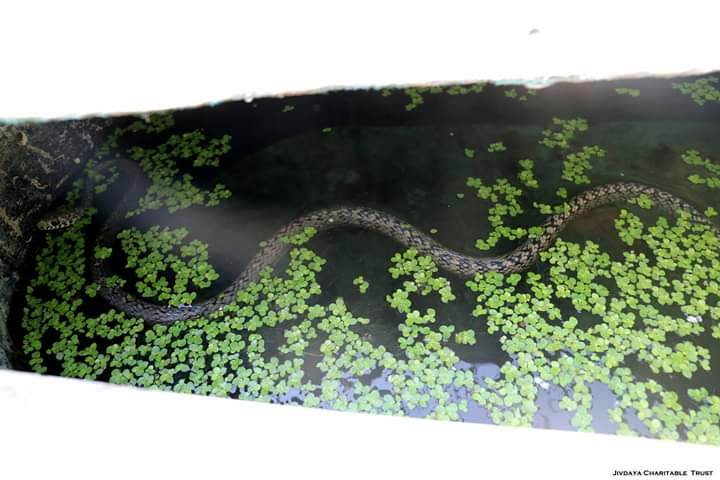Dehydrated Rat Snake (Dhaman)

What if you had the choice to pick an adventurous and fun career? You would think of a scuba instructor, astronaut, artist or perhaps sports. But there is one such occupation, right in the middle of the city! This occupation demands knowledge, skill, alertness and of course, courage. Make sure you do not mix courage with bravado as there is no room for pompous display here.
We are talking of a snake rescuer. Truth be told, handling snakes goes a long way in our civilisation. Bharat is often associated with snake charmers by ill-informed foreigners. Those snake charmers of yore exploited the snakes. They duped the people who would gather for the spectacle and think the charmer had an absolute control over the serpent. While the fact is that venom was extracted, and the fangs broken. The snake simply moved to the gyration of wind instrument. Snakes are actually deaf. In a nutshell, the snakes under their possession lived a horrific life.

If you come across a snake and call for help, JCT would send an expert snake handler to solve the problem. Snake handlers have a special set of skills and reservoir of knowledge that enable them to resolve the conflict while keeping in mind the safety of the snake, people and his own. Snakes like the Big 4 (common krait, Russel’s viper, Saw-scaled viper, spectacled cobra) need deft handling. A snake handler usually uses a tong to pick up the front end of the serpent while he holds the tail. Then the snake is captured in a bagger, which is tied and finally released in a safe environment away from humankind. This may seem pretty straightforward but on the field it gets complicated. Also, the snake rescuer has to manage an excited and overeager crowd. Remember that snake is a protected species under the Indian Wildlife Act, 1972 and any act done with malicious intent to harm or kill any serpent is a criminal offence punishable by law.
Some snakes can be trickier and complicated to capture; whereas some are almost docile. One such exquisite non-venomous serpent belonging to the former category is the rat snake, commonly known as dhaman. Dhaman is of a very swift and agile kind. It is usual quite long. This serpent is an almost doppelganger of the cobra, differentiated by streaks of black below its eyes. They are longer and of a different shade than cobra. The cobra is fairly easily identified by the hood. They are also adept and smooth swimmers.
Reptiles are cold-blooded i.e. they depend on the environment to keep their body temperature optimal. During winter, they come out to bask in sun for warmth whereas, to escape intense heat of summer, they sneak into burrows and go near a water body. Further, many kinds of snakes also hibernate. Our snake rescuer Amit Rami found a juvenile rat snake lying in a dried water tank. It must have crawled there to escape the heat but since there was no water in the tank, the snake was severely dehydrated. A couple of days more and it would have certainly perished. Besides, there was an abrasion on its head.
After proper treatment and nourishment were administered, the sleek and shiny reptile started showing rapid recovery in health. To maintain its physiology, the snake was given regular basking and soaking. This slim and muscular creature is set for release and soon would be in an ideal habitat going about its natural life.
Snakes are a fascinating species. The more you learn about them, the more you will be awestruck by the sophisticated adaptation of their bodies. Sine their bodies are quite slim, their internal organs are also arranged in this manner. Organs found in pairs, such as lungs and kidneys, are not situated side-by-side but one after another. Their jaw has many joints which enables them to open their mouth wide and swallow a large prey. Not all snakes use venom for hunting. Some use constriction to suffocate the prey. Snakes inhabit the land as well as water bodies. Sea snakes are quite mysterious and there is still a lot left to discover. However, it is a consensus among experts that sea snakes are far more venomous than terrestrial cousins. With the exception of Antarctica, serpents can be found nearly all over the globe. Although deaf, they capture the sound waves in the air with their forked tongue which they flick every now and then. Some snakes can locate their prey by the help of thermal sensors located in their skull.
Humans are prone to arrogance. We forget we are a part of a complex ecosystem that is based on interdependent relationships. We do not live in isolation. Earth and its flora and fauna have been here long before our species and will inhabit this terrific planet long after we go extinct. It is us who need the balance in nature. When we realize this, harmony with Mother Nature is not an act of spirituality or intelligence but a very practical approach. It is in this context that we should treat these creatures we come across. Thus, each serpent needs responsible handling.
JCT has given the clarion call for all environment/nature/animal lovers and empathisers along with compassionate souls to pool their resources to transform our society for the better. Join us, donate, volunteer… every bit counts.







